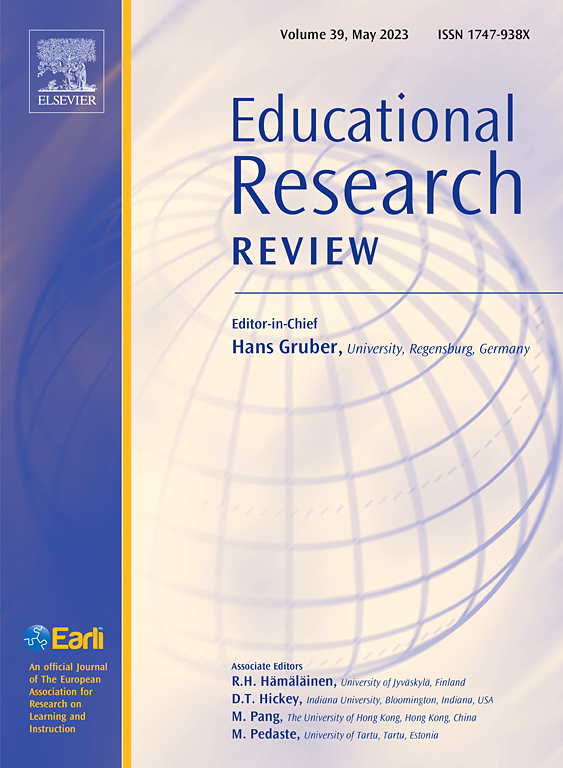数字化学习中通过提示搭建:学习成就有效性的系统回顾和元分析
IF 10.6
1区 教育学
Q1 EDUCATION & EDUCATIONAL RESEARCH
引用次数: 0
摘要
我们介绍了对68项关于数字学习提示的实验研究的荟萃分析结果,研究了哪些特征构成了学习成就的有效提示。首先,系统回顾揭示了不同研究中使用的提示的不同特征。其次,使用随机效应模型的定量荟萃分析显示,数字提示显著提高了学习成绩(d = .394),尽管对发表偏倚进行了调整,得出了更保守的估计(d = .220)。它们的有效性在很大程度上受到提示设计特征的影响。基于元回归模型,我们发现基于动作的提示(基于规则的AI) (d = .465)、为特定学习者群体设计的提示(d = .513)以及通用和定向提示的组合(d = .571)的效果最高。地区差异很明显,东亚地区的研究显示出比欧洲地区更大的影响。学习提示的有效性进一步受到学习领域和目标群体的调节。我们的研究结果表明,提示并不是一个普遍的解决方案,而是需要深思熟虑的实施。我们建议实现由学习者行为触发的基于行动的提示,使用日志数据根据专业水平定制提示。设计师应该保持提示简洁,以减少认知负荷。我们建议将基于学习目标的通用和定向提示结合起来。最后,确保学习者熟悉提示用法是至关重要的。这些循证指南有助于优化数字学习提示,以支持不同学习者的需求。本文章由计算机程序翻译,如有差异,请以英文原文为准。
Scaffolding through prompts in digital learning: A systematic review and meta-analysis of effectiveness on learning achievement
We present results from meta-analyses of 68 experimental studies on digital learning prompts, examining what features constitute an effective prompt for learning achievement. First, a systematic review reveals the different features of prompts used across various studies. Second, a quantitative meta-analysis using a random-effects model shows that digital prompts significantly enhance learning achievement (d = .394), though adjustment for publication bias yielded a more conservative estimate (d = .220). Their effectiveness is largely moderated by prompt design features. Based on meta-regression models, we find the highest efficacy for action-based prompts (rule-based AI) (d = .465), prompts designed for specific learner groups (d = .513), and combinations of generic and directed prompts (d = .571). Regional differences were pronounced, with studies from East Asia showing substantially larger effects than European settings. The effectiveness of learning prompts is further moderated by the learning domain and target group. Our findings reveal that prompts are not a universal solution but require thoughtful implementation. We recommend implementing action-based prompts triggered by learner behavior, using log data to tailor prompts to expertise levels. Designers should keep prompts concise to minimize cognitive load. We advise combining generic and directed prompts based on learning goals. Finally, it is essential to ensure learners are familiar with prompt use. These evidence-based guidelines can help optimize digital learning prompts to support diverse learner needs.
求助全文
通过发布文献求助,成功后即可免费获取论文全文。
去求助
来源期刊

Educational Research Review
EDUCATION & EDUCATIONAL RESEARCH-
CiteScore
19.40
自引率
0.90%
发文量
53
审稿时长
57 days
期刊介绍:
Educational Research Review is an international journal catering to researchers and diverse agencies keen on reviewing studies and theoretical papers in education at any level. The journal welcomes high-quality articles that address educational research problems through a review approach, encompassing thematic or methodological reviews and meta-analyses. With an inclusive scope, the journal does not limit itself to any specific age range and invites articles across various settings where learning and education take place, such as schools, corporate training, and both formal and informal educational environments.
 求助内容:
求助内容: 应助结果提醒方式:
应助结果提醒方式:


